Words and photos courtesy of The Model Car Critic
Vittorio Jano (born Viktor János to Hungarian immigrants) hailed from the Piedmont region of Italy in the early 1890s. He started off his career at Società Torinese Automobili Rapid, a car and truck company. In 1911 he moved to Fiat under Luigi Bazzi. In 1923 he made the move to Alfa Romeo alongside Bazzi and it is here Jano really made his mark as Chief Engineer. His first design was the 8 cylinder, in-line mounted P2 Grand Prix car which actually won Alfa Romeo the inaugural world championship for Grand Prix cars in 1925. In 1932, he produced the P3 model which was raced with great success by Enzo Ferrari when he began Scuderia Ferrari in 1933.
Jano also worked on Alfa Romeo road cars and designed a range of 4, 6 and 8 cylinder engines based on the aforementioned P2 unit that set the tone for Alfa Romeo architecture, with light alloy construction, hemi-spherical combustion chambers, centrally located plugs, two rows of overhead valves per cylinder bank and dual overhead cams. In 1936 he designed the V12 engine for the Alfa Romeo 12C, but that really struggled to make an impact and is thought to be the reason he left Alfa Romeo for Lancia at the end of 1937.

Some of his work at Lancia revolved around their Grand Prix efforts. The Lancia D50 was introduced in 1954, but 1955’s tragic loss of Alberto Ascari (only 4 days after he crashed into the harbour and miraculously walked away nothing worse than a broken nose, bruises and shock) and the Le Mans disaster of that year (where 83 spectators and driver Pierre Levegh died and 120 more were injured in the most catastrophic accident in motorsport history and caused Mercedes to retire until 1989) left a sour taste in Lancia’s mouth and they left Grand Prix racing. Ferrari took over the effort and inherited Jano that same year.
This turned out to be a great career move for Jano with his contribution to Ferrari being hugely significant. With the encouragement of Enzo’s son, Dino, his V6 and V8 engines pushed the older Lampredi and Colombo engines aside in racing. After Dino’s death in 1956 from Duchenne muscular dystrophy and aged just 24, Jano’s “Dino” V6 became the basis for the company’s first mid-engined road car; the 1966 206 Dino. The V6 and V8 went on to displace Ferrari’s V12 focus and their descendants continue to be used today. Like Enzo, Jano lost his own son in 1965. He became seriously ill that same year and sadly committed suicide in Turin.
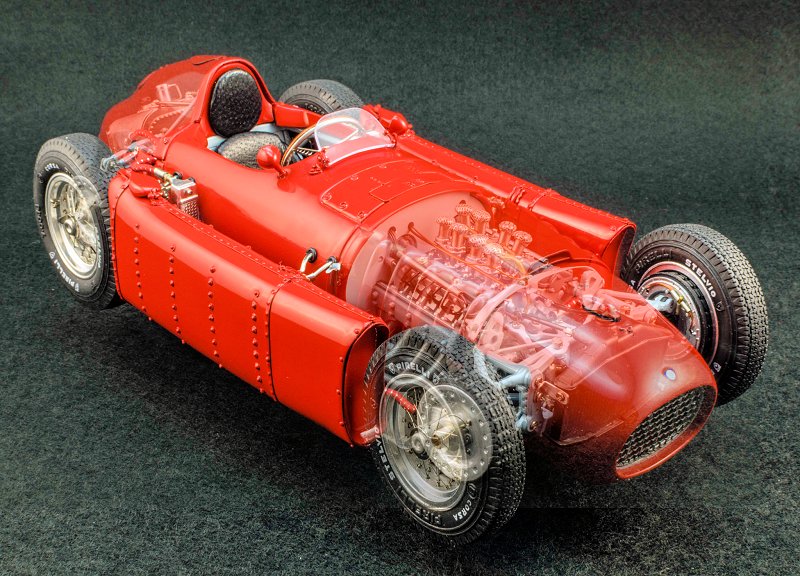
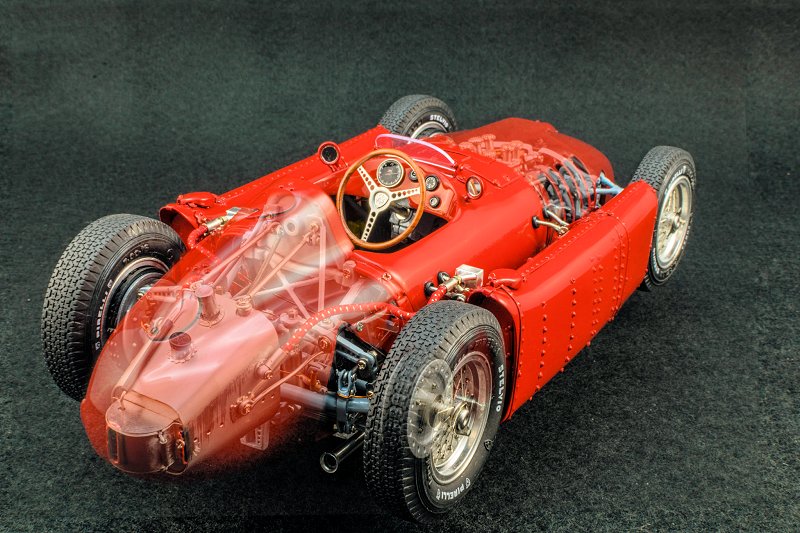
The D50 was perhaps way ahead of its time in Formula One. Jano’s design had some really innovative features. Among its characteristic features were a transaxle that lowered the centre of gravity significantly, a light-weight compact 2.5 litre V8 engine with a 90 degree cylinder angle and four overhead camshafts that produced 260bhp. The engine formed a stressed member of the chassis by foregoing the upper tubes between the cockpit structure and the front suspension in the space-frame tubular chassis. Only two lower rails were needed to hold the engine in place. The aerodynamically-shaped pannier fuel tanks were particularly useful – they could hold 200 litres of fuel which meant the D50 could go a whole race without needing to refuel, thus being a huge advantage over competitors with conventional fuel tanks in the tail. To get the driveshaft, which was rotating in concert with the crankshaft revolution, to bypass the driver cabin, the engine was tilted off the longitudinal axis by 12 degrees to the left. This allowed the driver to sit really low and improved the centre of gravity and aerodynamics of the car. The gearbox was mounted transversally just in front of the de Dion rear axle. These were ground-breaking features that made the D50 one of a kind. These works team Lancias in period were beautifully made, expense no object. Every suspension and ancillary mounting point on the D50’s lightweight multi-tubular chassis was precision-machined to aeronautical tolerances. Everything about these cars breathed quality.
At the beginning of the season, this model was already being viewed as the only rival to the Mercedes-Benz W196. Accordingly, two-time world champion Alberto Ascari was signed from Ferrari to lead the team, alongside Gigi Villoresi and a young Eugenio Castellotti. On 24th October 1954, the Lancia D50 made its debut at the Spanish Grand Prix in Barcelona, the last event of the season. Ascari took pole position in qualifying and drove the fastest lap of the race with a time of 2 minute 18 seconds. However, a failed clutch forced him to retire in just the ninth of 80 laps. The revolutionary spirit started gloriously, but it came to an abrupt end – at least for that season. The image below shows Vittorio Jano on the far right, sitting alongside Luigi Villoresi, Alberto Ascari and Eugenio Castellotti.
No other Lancia automobile had ever caused such an emotional stir in competition and among the public, not to mention its lasting impact on the company’s fortunes. With the demise of Alberto Ascari shortly afterwards, the costs from the development of the D50 and the pursuit of victories in prestigious Grand Prix racing proved to be too much for Gianni Lancia to bear and that is when Ferrari took over the Lancia team and the entire D50 fleet after Lancia withdrew from racing on 31st May 1955. From 1956 onwards these cars were used in the Grand Prix races as Lancia-Ferrari D50 and then simply named Ferrari D50. Juan Manuel Fangio won his fourth world championship in a Lancia-Ferrari D50. During their competition lifespan, D50s were entered into 14 World Championship Formula One Grands Prix, winning five of them.
As is usually the case with CMC, they have a few variants of this model in 1:18 form:
* Plain red (#M-175 and unlimited in production)
* The #26 car driven by Alberto Ascari in the 1955 Monaco GP (#M-176 and limited to 1,500 pieces which have already all sold out on pre-order)
* The #30 car driven by Eugenio Castellotti in the 1955 Monaco GP (#M-177 and limited to 1,500 pieces).
The recommended retail price is 497EUR for all three variants, so it is quite nice to see a premium hasn’t been placed on the latter two variants. The plain red car is already available in shops, whilst the #26 and #30 cars are expected to be delivered sometime in 2018.
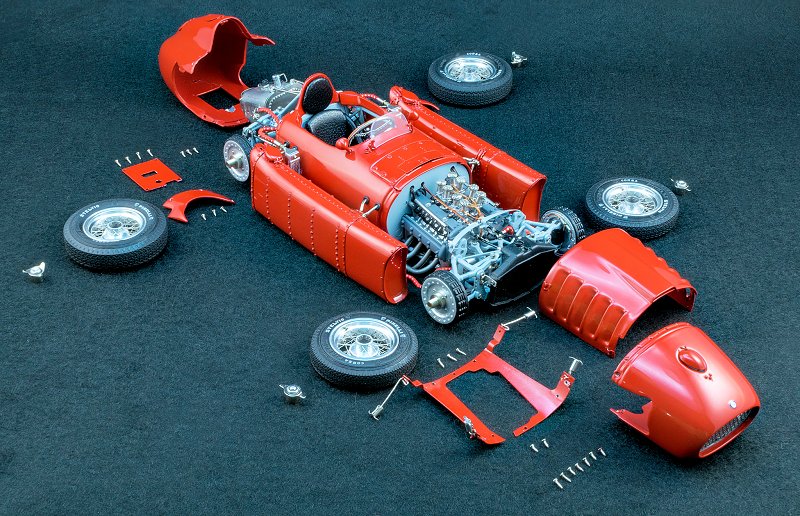
CMC were very kind in sending me this sample to review after the apparent success of my Talbot Lago T150 C-SS review and I really appreciate the gesture to allow me to cast my critical eye over another one of their (hopefully) detailed masterpieces! Again, I was provided this press sample in a standard Styrofoam shell, so unfortunately I cannot comment on the unboxing experience.
Like the Lago, I spent a decent amount of time handling the D50 and playing around with the opening parts and ogling the details dripping from this model. Some people might baulk at the price of this thing – heck, close to 500EUR for a model is a significant investment in anyone’s books, but like a piece of fine art some of CMC’s models have been known to appreciate quite nicely in value. You simply cannot compare this kind of model to something like a Davis & Giovanni Lamborghini which I’ve seen offered for more than the D50. Even if you have zero interest in the subject matter of the model, I can almost guarantee every collector will be impressed with the level of detail found in a CMC model – and this one is certainly no exception!
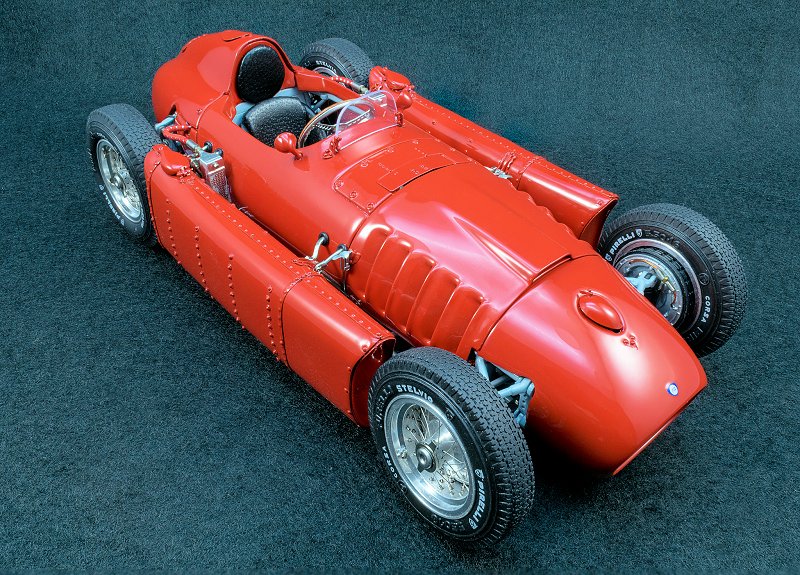
Made up of 1,598 individual parts and various materials including leather and stainless steel can this model top their Talbot Lago from earlier on in the year? Prepare your eyes for the visual feast of details as we strip the model back, piece by piece!
Whilst researching the Lancia D50 online, I came across a set of pictures taken at Jim Stokes Workshops Ltd. in Waterlooville, England. These pictures showed the CMC team from Germany at Jim Stokes taking a 3D scan of the vehicle at the end of May 2016, with the final production version going on sale in December 2017. Just think about that for a second – it took a year and a half from scanning stage to shop shelf, which surely makes you appreciate just how much effort goes into creating a CMC masterpiece! Here are those photos….
Only two of the original cars survive and they remain on static display in museums in Italy, I believe. However, a number of original components, including engines and gearboxes were stored prior to the Ferrari move. These parts reappeared many years later and were used by Jim Stokes Workshops as the basis of a recreation project. A total of six cars have now been re-created for use in historic racing. Check out this LINK for a nice background story of how these recreations came about.
So, we’ve seen where the model hails from and now it is time to see how CMC has scaled down from 1:1 to 1:18 – have they done it justice? The red paintwork is sublime and looks stunning under any light. I’ll let you take a full tour of the exterior of the model, before we delve into the finer details.
You wouldn’t expect CMC to leave out the underside on the model and they certainly haven’t disappointed in the case of the Lancia D50. I can guarantee you, this is going to be one model that collectors are going to have difficulty in figuring out how to display it – even the bits down below look stunning!

Take a look at this lovely monoposto seating position. I think this is one of my most favourite angles of the car as you get a good look of the shark-like gills of the engine cover, fuel panniers, wooden steering wheel, splendid wheel and tyre details plus a hint of suspension elements. One thing that I’m not so keen on is the silver screws. They don’t appear to be as screws on the real car, rather some sort of bolt or rivet – but I can forgive CMC for having to use screws otherwise how else would collectors be able to peel back the bodywork? What vexes me is that they used red painted screws for the whole rear section, but the small side panels and indeed the underside of the car have all been left silver. It makes the model look a bit too modern and clean, and I think painting all the screw heads matching red would have elevated the overall look just that little bit more. Certainly not a major bugbear, but when CMC are operating at this level of detail you sometimes (perhaps wrongly?) come to expect more of them.
Note that the little windscreen (deflector is probably more accurate) as fully adjustable back and forth, which is a very nice touch and also doesn’t feel fragile enough that you’d be worried to snap it off if you moved it even a millimetre.

Now we get to my favourite part of the review. If the devil is truly in the details then CMC have a special place in Hell reserved just for them, because the Lancia D50 is yet another masterpiece from the team! Not a perfect masterpiece, as we will see moving through the review, but in some ways this model has topped the Talbot Lago – something I wasn’t expecting to write anytime soon. While the Lancia badge on the nose of the D50 may lack a bit of definition around the lettering, don’t forget that this is a pretty small badge to begin with. I do wonder why CMC didn’t use a proper 3D photo-etched badge that is clearly present on the replica they scanned for this model?
Onto those revolutionary fuel panniers now and looking at these up close and indeed afar leaves one word stuck in my mind….”riveting”! Yes, the pun is intended, but take a look at the rivets all the way along the fuel tanks. The detail is stunning! I think I’m being overly critical when I say the domed section of the larger rivets may be slightly out of scale compared to the real car, but in pure isolation this is a 10 out of ten effort by CMC on this aspect of the model.

The engine cover is held on by 4 little metal and spring-loaded hooks, 2 either side. CMC include a set of curved tweezers in the box to lift these hooks out of the way to remove the engine cover. Again, the size of the screws irk me somewhat, but I fully understand that they’re probably there for structural integrity and to make sure everything stays together properly. The rubber grommets that hold the panniers to the main body look good, however.
What I’m assuming are the radiators are attached between the fuel tanks and the fuselage of the D50. Based on pictures I’ve seen of the real car, the bolt looks realistic. The radiators themselves could certainly be better – the model only has 5 banks of coils, whereas the real cars I’ve seen seem to have 8 or 9. I would also like to have seen a better depth of realism on these parts by CMC putting real coils with gaps in the radiator housing. I don’t believe it is beyond the team’s ability, but maybe beyond the cost of the model? Either way, that particular detail would have added an immense amount of realism to the model. This is a detail you may not notice unless you are looking up close or by the fact I’ve pointed it out.


Just like their Talbot Lago I reviewed, the Lancia D50 has a fair amount of what you might call Easter egg details. Little bits that come off and open up that you might not expect to that make you appreciate the model all the more so. The flaps on the fuel panniers lift up to reveal the screw caps to fill her up with fuel. It doesn’t appear that these caps unscrew, nor would I expect them to. Same goes with the single flap at the front for the radiator and the two flaps at the rear for the auxiliary fuel tank.
By opening the flaps at the rear, you get a cheeky look inside the bowels of the model – this should get you salivating for later on!
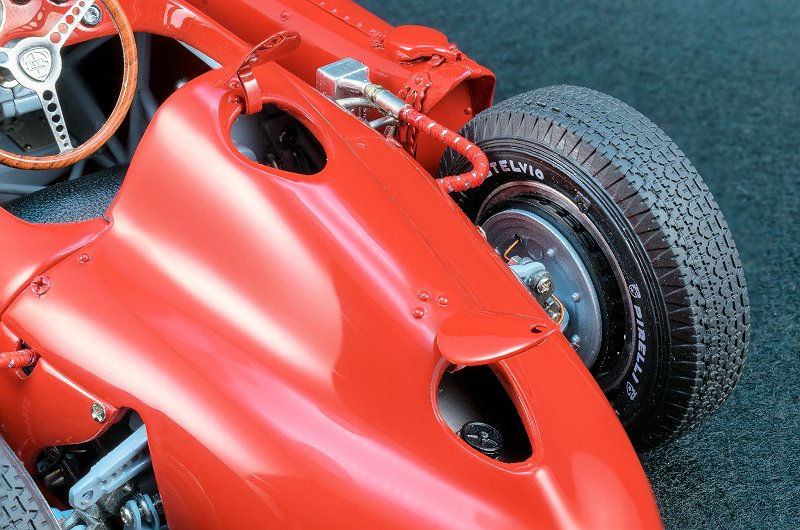
On to the wheels now and I don’t think much needs to be said about them really. They are just lovely! Everything from the tyre treads to the branded lettering and of course the intricate weaving of the spokes through the centre and outer parts of the rim scream detail and quality. Well done wheels are always one of the highlights of any model for me – the entire body could be 100% accurate, but if the wheels look terrible (ahem, Paragon BMW models, ahem) then the entire model is spoiled in my opinion. Well done CMC on leading the way in this area time after time! More on the wheels later…
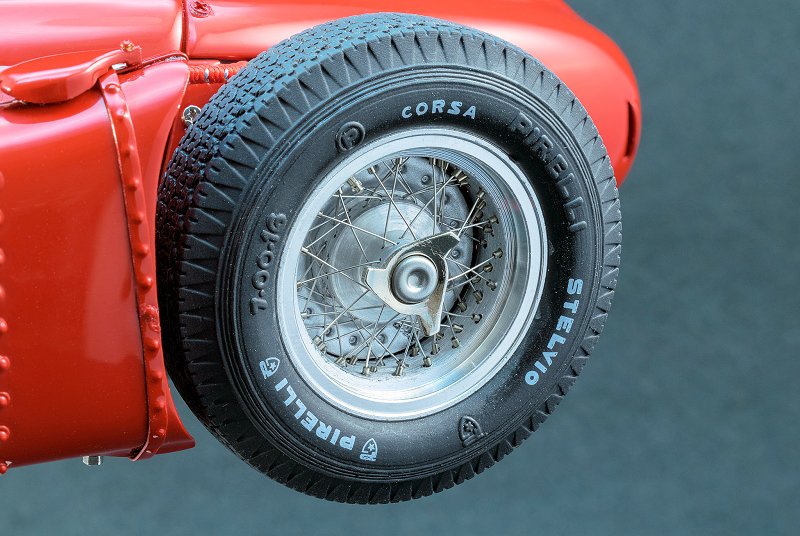
The next area you would never expect a CMC model to fall down on is the interior and it pleases me to say they’ve done another stellar job here. The seat is genuine leather in black and I personally think the scale of it looks good. You can see parts of the lightweight multi-tubular chassis and various bits of cabling when you peek inside as well.
The wood effect steering wheel is rather stunning to look at. The grain looks convincing and the colouring looks great. My OCD keeps diverting my attention to the slightly off-centred holes cut into the three spokes. The dials themselves are another fine detail. Although these pictures show them off up close, don’t forget just how small they are in real life, so it is good to see they are quite legible – especially the Jaeger rev counter complete with the 7,500rpm red line limiter.

Looking deeper inside the interior we can see other details, such as the gearlever, handbrake and is that the yellow part the ignition, perhaps? Whatever it is, the details such as the linkages for the gearlever and the bits of cabling around the cockpit really add to the realism and is impressive to see in scale form.
Here comes the fun part of the review. The part where we start to undress the model and take it apart, bit by bit. If you are the type of collector who likes to create dioramas of scenes such as a pit lane garage or the like, you will absolutely love this model. I have personally never seen a model have the ability to strip down to such a level. You just know this is where the bulk of your nigh on 500EUR goes to and by the end you can pretty much justify the price. First to come off are the wheels. With a small amount of force you twist off the centre-locking wheel nuts (either clockwise or anti-clockwise, depending on which side of the car you’re working on) and the wheels themselves slide off easily. Sadly I wasn’t able to do this on my Talbot Lago review, because the nuts were put on so tight I feared snapping something trying to remove them – but at least there was the spare wheel in the boot that you could get a close look at.

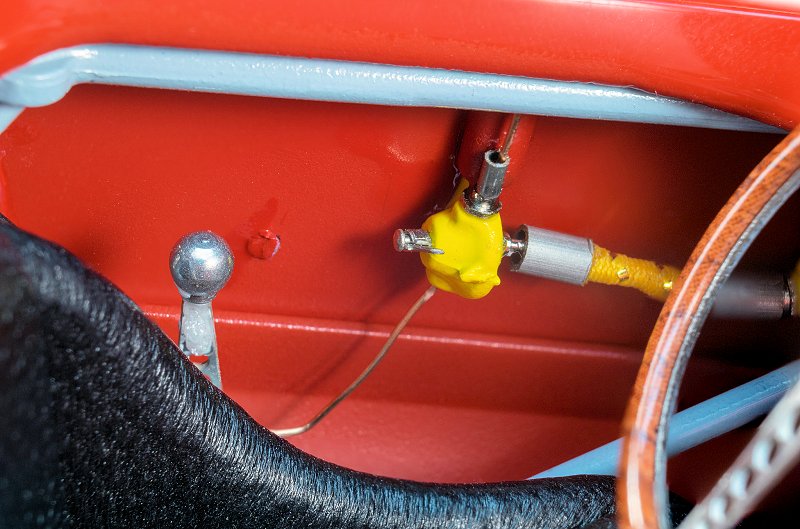
From this point you get to admire the craftsmanship of the wheels from an even closer vantage point. I dread to think just how much time those artisans (I think they deserve that noun) spend making these on the production line! The white lettering on the tyres and also the finish of the rims themselves do make it look like they were made back in the 1950s and provide that aged impression, don’t you think?
Once the wheels are off you come to regard the drum brakes, brake lines and suspension set up of the D50 and everything looks well replicated. You may notice that the rear suspension arm in the picture below is broken – when I opened the model I found a rogue nut and screw and assumed it was put in the packaging in error, but it turns out it was from here and I only realised this after I had shot all my photos. In the last photo you get a glance inside the engine bay through those basking shark-like gills either side of the engine cover, plus the front suspension setup poking through a cutout in the nose section.


Lift off the engine cover and you are welcomed by the sight of that pioneering 2.5 litre V8 engine. You immediately take in the four dual-throat carburettors, the copper and black cabling running throughout and various other bits and bobs scattered around the engine bay. At first you’re impressed, but then you compare the engine to the real car and your heart starts to sink a little. Has CMC really let this model down in the engine department?!?! And to a degree, yes. The detail is so far off that of the Talbot Lago, there is simply no denying that. The copper piping that snakes through the four banks of carburettors lacks finesse and is rather crude. The wire covers for the carburettors themselves are too thick and should be more of a thin mesh wire. The bases of the carburettors that bolt onto the engine block should be proper metal blocks, rather than formed plastic with zero definition to the bolts themselves. Elsewhere the bolts lack definition and colour and instead have just been painted to match whatever engine part they are connected to. In a really disappointing way, the engine is probably this model’s weakest point and it genuinely pains me to say this! The engine looks pretty good when viewed from afar, let’s be honest here, but no doubt you will feel let down the closer you get.

There is another flap at the base of the wind deflector that lifts up. You’ll have to excuse the toothpick, but the hinge offers no resistance so I needed to keep it open for the shots below. I’m not sure what functional purpose it has on the model – extra cooling perhaps? – but it offers you a somewhat dark glimpse into the section between the engine and cockpit. It is nice to see the added detail of the cabling continuing through the bulkhead into this section.
Flipping the model upside down now and there is yet more to come apart on this stunning looking model. As mentioned above, I don’t know why CMC couldn’t have paint matched the screw heads to the bodywork. The modern silver finish jars with the classic look and feel of the model. An improvement for future models, perhaps?
Unscrewing four tiny screws from the small rectangular piece on the underside of the rear section of the car. I have no clue what that part sticking out does, however.

The nose cone comes off as well alongside the section that the four engine cover clips are attached to. Here you get a good view of the radiator that usually sits behind the gorgeous and well-engineered mesh grille in the nose. If I was being really picky, I would have liked to see some more depth to the design of the radiator – but I am being really picky here and it is surely well executed otherwise including the black piping. The independent front wishbone suspension with transverse leaf springs are also clear to see and frankly works of art. You can see even more detail on the back of the drum brake too.
You guessed it! The entire rear section can be unscrewed and removed as well. What lies before you once you’ve carefully pulled back the heavy hunk of a piece is literally a spider web of cables, suspension parts and section of the tubular frame. A myriad of details ready and waiting to be taken in, including that de Dion tube that sits below the supplementary fuel tank. The red and silver braided wires are nice, but looking at the real car it seems they should be made out of the same sort of plastic on a vacuum cleaner hose. Personally I like the look CMC have gone for better, but if we’re talking replicating realism here, the hoses are more welcome.

Resting the model on its side allows you to comfortably see those rear transverse leaf springs as well as the five speed gearbox mounted transversely, with the final drive at the rear axle. All these details go some way in making up for the poorer than expected engine execution.
With every single part removed and the model resting on its side allows you to take in all that stripped back beauty of the undercarriage of the model. Like the front and rear sections, this oozes quality and details and is exactly what CMC are famed for in the modelling world. Simply stunning! We also get a solid look at the exhausts running the length of the model and the rivets present along the bottom of the fuel panniers and scattered across the base of the cockpit.
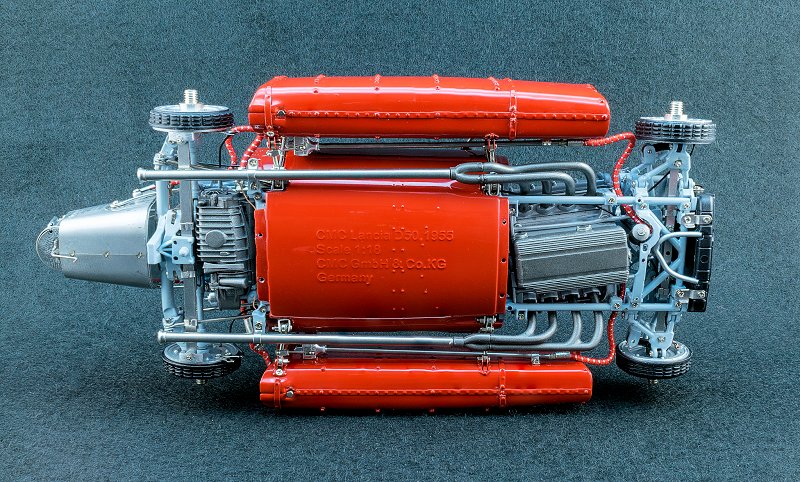
Here is a great shot showing you all the pieces of bodywork and screws that come off the model – see what I mean about how good this model would be for dioramas?
Last but not least, CMC have included another Easter egg with the Lancia D50. A booster trolley containing a battery that hooks up to the assist start device that plugs into the little silver disc protruding from the side of the gearbox shown above. This is a really nice addition and I have seen collectors create nice little scenes with figures holding onto the trolley and plugging in the assist device – again, great for a diorama setup. The detail on these parts is very nice, from the little sticker on the battery (although the printing alignment was a bit off on my example), to the battery terminals themselves and also the way the battery hooks up to the assist device.
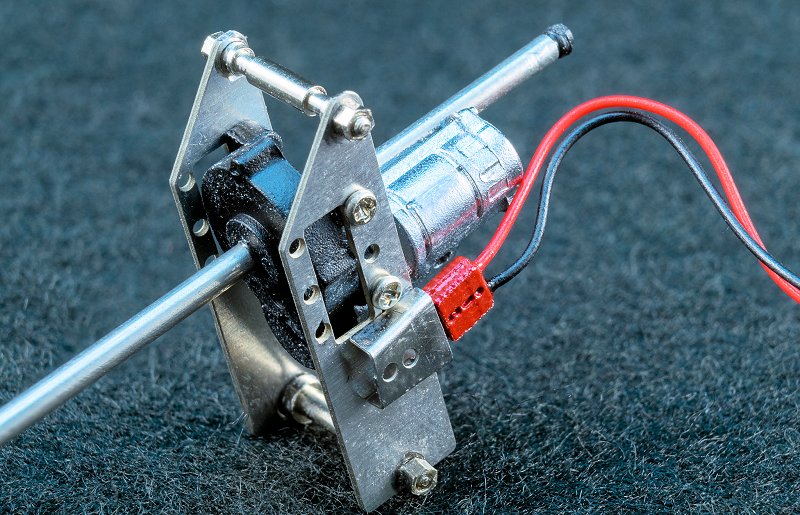
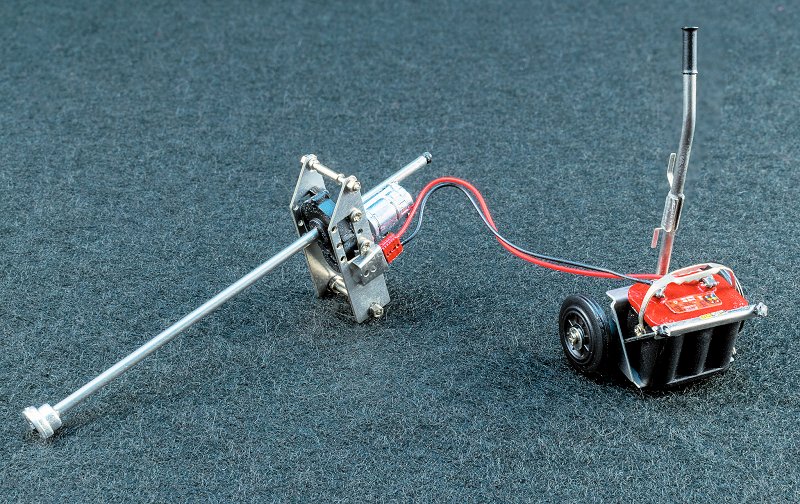
Would I buy one with my own hard earned cash? If I was an avid Formula 1 collector, and especially an historical collector, I would probably say yes. The real racer was such an innovative machine that it is hard to ignore its significance, especially when you consider that Alberto Ascari died while on the Lancia team and also the team itself going out of business. If you are the more average collector sitting on the fence about this CMC Lancia D50, I would say a 50-75EUR or so discount on the price would have you sat bolt upright and reaching for your credit card. Taken as an overall package, this model is simply spectacular. The suspension detail, the fact that you can take most of it apart and bask in the glory of the incredibly detailed innards is a real selling point for me, as I’m sure it will be for so many collectors worldwide. The main fly in the ointment for me would be that overall engine detail. The only other CMC model I can personally compare it to is the Talbot Lago I recently reviewed and that had an absolute corker of an engine and certainly set the bar incredibly high for their next release, whatever subject matter it would have been. Had the rest of the model not been so detailed I think collectors would take umbrage at that 500EUR asking price. Luckily those other aspects are present and mostly correct, so I think most people will be kept satisfied in that respect. At the end of the day, I am but one lowly opinion – the sales figures and thoughts of you, the collector, will determine the success of this model not just now, but also in years to come when we’re all living in a depressing world of sealed resin and plastic models! I will say this has been one of the most fun models to review, purely because the Lancia D50 has been like an onion – you keep peeling away another layer and discovering more and more details to behold. Oh, and like an onion it’ll make you cry when you can’t remember which length screw is supposed to go in which hole!
I’ll leave you with a couple of pics my friend Koen put together for me based on a couple of my own shots – I love these see through type pictures! ©Koen
As always, thanks for reading and I hope I convinced you at least one way or the other regarding the CMC Lancia D50.
Review portfolio: themodelcarcritic.com
Facebook page: www.facebook.com/themodelcarcritic
Instagram page: @themodelcarcritic


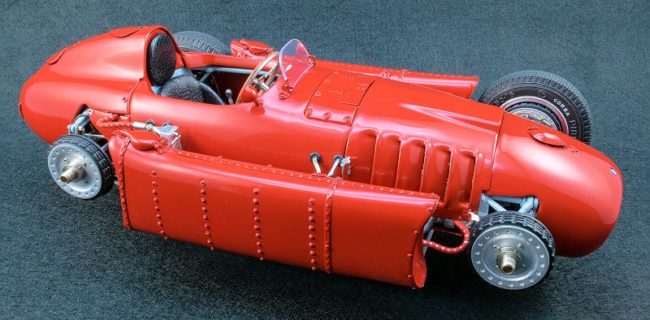
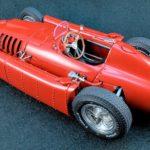



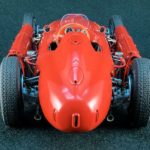

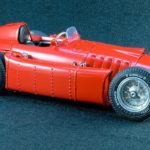
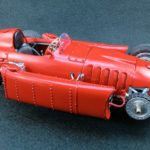

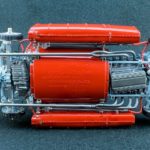
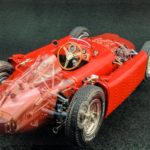

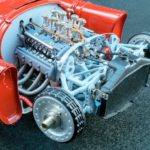

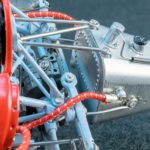


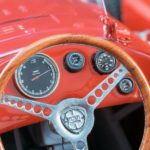

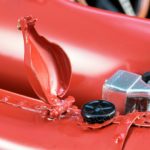



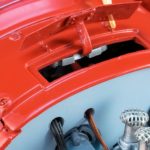




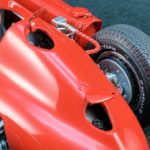



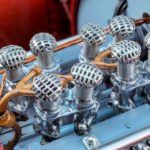
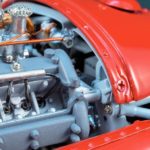


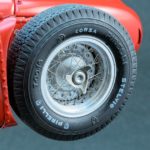







Thanks for the great review. The model is quite impressive but also quite expensive. The detail is exceptional, but with the CMC brand nothing less can be expected. The model doesn’t seem fragile either, so accessing various bits on the piece shouldn’t age you.
On the flip side out team did receive a press sample too. Our example of riddled with issues. Some include four tires did not touch the floor. Front looked as a dog taking a leak! Also no matter how hard we tried or what we did the rear section could not be parted from the body. So my direction to collectors ensure you inspect every inch of this lovely model and ensure your receive a 100%.
Good review! I recently bought one of these models and am generally pleased with it. There are a few minor details that were lacking, as you mentioned here. One little detail that nobody seems to have noticed is that the battery on the cart for the starter is a modern Optima battery! Even though that’s an extra accessory, why did they go to the trouble of making these two extra pieces that are otherwise great, and put that modern battery on it? You can’t even take the label off to make it look period-correct because the top of the battery is distinctly Optima red and has their unique rounded corners, while the case has the individual cylindrical cells that are unique to a spiral wound AGM battery. There were no batteries like that back when the D50s ran! I guess you could pretend your model is of a replica D50, but what fun is that, especially if it’s wearing a famous number? What was CMC thinking?